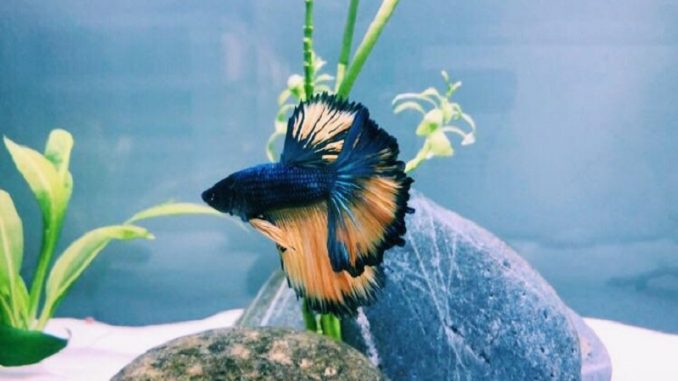
Many people have seen or heard about betta fish, usually displayed in tiny tanks by themselves because of their aggressive fighting tendencies.
Betta fans would call their behavior territorial, as they puff out only when they feel their space is being threatened, and they are more territorial with other betta fish, particularly males.
Paradise betta is a made-up name that is sometimes used as a general term to talk about the species of betta fish commonly found in pet stores (as opposed to the ones in the wild). And sometimes the name paradise betta is used as an alternate moniker for the mustard gas betta, a particular variety of betta fish.
A growing number of aquarists believe that keeping these gorgeous creatures isolated in minuscule settings is far from ideal, and prevents them from thriving.
If you are housing a single betta fish, you should have at least a 5-gallon tank with a filtration system. You should never keep a betta fish in a bowl.
TABLE OF CONTENTS
Paradise Betta Facts & Overview

| Category | Rating |
| Care Level: | Moderate |
| Temperament: | Territorial |
| Color: | Various |
| Lifespan: | 3-4 years |
| Size: | 3 inches |
| Diet: | Omnivore |
| Family: | Osphronemidae |
| Minimum Tank Size: | 15 gallons |
| Tank Setup: | Freshwater with plants |
| Compatibility: | Non-aggressive community |
There are actually 73 different species of betta fish, only some of which are used in the aquarium trade. This might be one reason that the different varieties of captive betta fish are referred to as Paradise Bettas.
Betta fish are native to Thailand, Cambodia, Laos, Vietnam, Malaysia, and Indonesia. If you have heard them referred to as Siamese Fighting Fish, that comes from the period in history when Thailand was called Siam.
In the wild, betta fish are found in shallow, slow-moving warm water: ditches, pools, streams, and rice paddies are common homes for betta fish.
Honestly, betta fish are some of the most beautiful fish in the world, whether you are rating beauty in the aquarium or in the wild. They are also smart fish that can be trained–they can do simple tricks and also recognize their caregivers!
Many people are put off by their seemingly aggressive behavior, but as I mentioned, it’s more territorial than aggressive.
Typical Behavior
Betta fish are known for their lung-like organ, which is called a labyrinth. This special quality allows them to gulp air from the surface of the water.
Pro tip: The labyrinth organ is what causes people to think that providing only a bowl with no filter is acceptable for the betta fish. Really these amazing fish deserve better than a still water bowl. They need space, and if possible, a larger community tank.
Betta fish are entertaining to watch because they are very active. Due to their high activity, they also have large appetites.
Known as aggressive fish, bettas are very protective of their space and will lash out when they feel threatened. That’s why it’s very important that you, as their caregiver, are aware of their territorial tendencies, and provide tank mates that won’t threaten their space. That includes other bettas, particularly males. Two male bettas should never be housed together, or they will both likely die.
If they feel their space is being invaded, they will defend it. That’s why you’ll sometimes see them coming right over to the glass to give humans the stink eye. Their gills and fins may even puff up in defensive mode.
With the right care, it’s possible to significantly decrease their aggression (by removing the circumstances that make them lash out.) However, as their owner, it’s important to remember that they have the capacity to be pretty mean when they feel they’ve been wronged or bullied.
Appearance
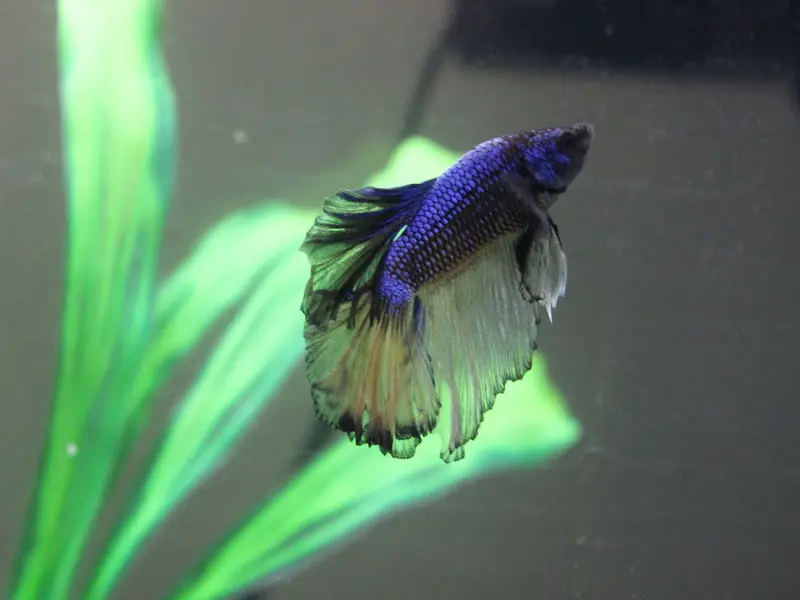
Paradise betta fish, or selectively bred bettas, will reach their full size of 3 inches (7.6 cm) at about 7 months of age. Their final size is determined by the quality of care your betta gets, both before they are in your care and while they are in your care.
Although there are many variations in their appearance, they are all stunning, both in regards to their color and their flowing tails and fins. Their bodies are tiny contrasted with their long and wide fins and tails.
They actually have the ability to flash their colors more brightly when they are mating or when they feel threatened. It’s pretty amazing to watch them flash.
Distinguishing between males and females
While the differences vary among the types of paradise betta, the most noticeable distinction is that the fins on the male bettas are much larger and longer than those of the females.
Types of Paradise Bettas
If we are referring to betta fish that are sold for the aquarium trade as paradise bettas, they are classified by their color, tail type, and pattern. This is because they were all selectively bred for different appearances. I’ll start with the color classification, as that’s where our Mustard Gas betta is classified. I want to spend some time with the mustard gas betta since that is sometimes called the paradise betta.
Mustard Gas Betta Fish: Mustard gas betta fish have an amazing bi-color hue and their body and fins are different colors.
The body section of the mustard gas is darker, usually a green or blue shade. Their fins, however, are a lighter yellow or orange.
Most of the mustard gas bettas bred today only have one parent from the original breeding, and are actually a mix of a male mustard gas betta and a female of a different type. These mixes are quite lovely to look at.
Additionally, there are other fish that are falsely called mustard gas bettas because their bi-color distribution is similar to a true mustard gas betta. Perhaps the paradise betta is a moniker referring to these mustard gas lookalikes?
Other betta fish categorized by their color include:
Black Orchid Betta: The black orchid betta is very dark, and may have blue or purple highlights. There are 3 different types of black orchid bettas.
Blue Betta: Blue bettas come in a variety of blue hues, including iridescent.
Green Betta Fish: The green betta is as rare as the red and yellow betta are common. These fish usually have a turquoise hue, and sometimes look iridescent.
Pink Betta Fish: These beauties are often nearly translucent, but sometimes will have a brighter pink hue, and often have purple, red, or white highlights.
Purple Betta Fish: Purple bettas have violet or blueish purple, and sometimes the hue varies on different parts of the fish.
Red Betta Fish: This is the most common betta fish color. The dominant hue, it nonetheless manifests in different shades of red.
Rose Petal Betta: This type displays a huge variety of colors ranging from electric light blue to dark blue to copper, with a face that is darker.
Yellow Betta Fish: These are also quite common, but the hue varies from soft to bright yellow.
White Betta Fish: It might seem boring to have an all-white fish when others are so colorful, combined with a distinct tail pattern, these fish can look like royalty in your tank.
Next, captive bettas are classified by tail type (size and shape), because let’s face it, the flowing fins are showstoppers.
Crowntail Betta: First bred about 25 years ago, the Crowntail is extremely popular in the aquarium trade, named for the spikey, crownlike appearance of its fins. Females have shorter tails and lighter colors than males.
Delta Tail Betta: This variety has a large, uniform tail that resembles the Greek letter D (delta.) Towards the body it is narrow and the edges are wider, so it looks like a triangle.
Double Tail Betta: With a self-explanatory name, the double tail has two tails that are distinctly separate.
Elephant Ear Betta: Also known as the dumbo betta, this betta is named for its pectoral fins rather than its tail. Those fins resemble elephant ears.
Halfmoon Betta: The halfmoon betta’s tail is a large half-circle that resembles a half-moon. Their personalities are more aggressive.
Plakat Betta: This tail variety is not your typical betta, as the tails are round and short, and their fins are also shorter. When first bred, Plakats were intended to be fighters and used as such.
Rosetail Betta: This variety is similar to the half Moon betta’s tail, but the fin exceeds 180°, resembling a rose.
Veiltail Betta: This tail is the dominant pattern, and if you are breeding, you’ll have more success with this one. The male has a long, flowing tail that swoops downward, while the female has shorter, lighter fins.
The last way captive Betta Fish, or paradise bettas, are classified is by color patterns on their bodies and fins. Again, many of these patterns are the result of years of selective breeding, and as a result, these are not found in the wild.
Butterfly Betta: These have a solid body color and a pale and iridescent hue at the base of the tail and fins, with the rest of the tail and fins appearing as translucent or white.
The Dragon Scale Betta: This fish’s body has a deep color with iridescent scales that look like dragons.
Koi Betta: These were selectively bred to look like a koi pond fish, and are a variation of the marble betta.
Marble Betta: These fish’s bodies exhibit light or pale colors with deeper colors making a marbled pattern.
Habitat and Tank Conditions
First, bettas are not fond of loud noises, so try to put their tanks in a quiet room or area in order to reduce their stress. Second, bettas are jumpers that often come to the surface, so you want to make sure you have a tight-fitting lid.
Inside the tank, beginning with the substrate, paradise bettas need a soft substrate such as pebbles or sand. Their fins and tails are long and flowing, so it’s important to protect them from a rough substrate that might damage or cut them. Lay an inch or two of the substrate along the tank floor.
You’ll also need a good filter; please don’t try to raise these fish without a filter. However, they don’t like a very strong current, so you can place a plant in front of the filter uptake to disperse the water flow.
Choose artificial light over direct sunlight for paradise bettas. They like moderate to strong lighting, but prefer an LED or luminescent light to sunlight.
You should also invest in a submersible water heater as these fish need tropical temperatures.
Your betta fish will appreciate plants: I recommend live plants as they help to clean the tank and also won’t scratch the fish as some artificial plants can.
Water Conditions
Consistency is the number one factor when it comes to water parameters. A sudden or drastic change, even within the acceptable parameters, can cause illness or death. This is why I suggested the heater and filter in the previous section. It’s also important to check the water levels regularly.
You also need to dechlorinate the water and keep ammonia levels low (another reason the live plants are important.)
The optimal parameters to ensure the best quality of life for bettas:
- pH levels: 6-8
- Water hardness: 5-35 dGH
- Nitrate: less than 40 ppm
- Nitrite: Zero ppm
- Water temperature: 74° to 81°F (23.3° to 27.2°C)
You should run a complete cycle of water before adding the betta fish. Then perform a weekly 25% water change.
What Size Aquarium Do They Need?
If you are housing a single betta fish, you need a 5-gallon tank. If you are putting a betta in a community tank, you should start with a minimum of 15 gallons, depending on how many and what kind of fish are sharing the space.
Tank Mates
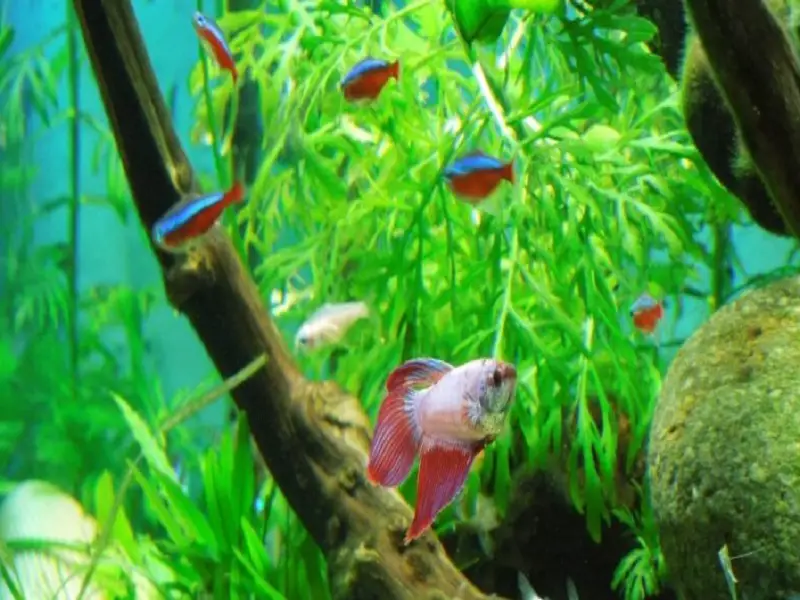
Because betta fish can get aggressive when they are placed in situations where they feel threatened, it is important to mindfully consider which tank mates, if any, you’d like for your betta. If you do decide on a community tank, make sure, first of all, that the bettas have enough room to stake out their territory.
Any betta tank mates should be larger and able to defend themselves if the betta acts up. Avoid fish that will nip at the paradise betta’s luxurious fins and tails.
Choose fish that are not brightly colored like the betta. Bright colors may make the betta feel like it has to compete, which could lead to conflict.
Suitable tankmates:
- Catfish
- Gouramis
- Large Ghost Shrimp
- Mollies
- Rasboras
- Tetras
Keeping Paradise Bettas Together
The main issue with keeping paradise bettas together is the aggression between the males, so you should never keep more than one male in a tank. In their effort to assert their dominance, injury and death is likely outcome.
You can keep up to 5 female bettas together, or 1 male and up to 2 females. However, the possibility of a fight is never off the table. With multiple bettas, you should always watch for signs of strife.
Diet
A varied diet will positively affect your betta fish in myriad ways, helping it thrive in tangible ways. If you’re feeding your bettas correctly, you’ll notice that they are active, less stressed, and have excellent coloration.
Bettas are carnivores, and there are special betta flakes made just for them. However, it’s good for them to have live food as an occasional treat. You can offer bloodworms and brine shrimp.
Feed your paradise bettas two times a day, but only offer them a small amount of food; one pinch of flakes is sufficient. They will overeat if you allow them to, and this is not good for their health.
If you see your betta swimming abnormally or exhibiting less energy, there is a good chance your betta is overeating, and you can withhold food for a day.
Care
Paradise bettas are very susceptible to cuts and scrapes due to those fragile and delicate fins and tails. They are often damaged by tank mates (which is why it’s important to watch who you pair them with) and scratchy substrate. It’s important to check them often for cuts and scrapes as you want to treat them before they get infected.
They also are prone to the viral infection called Lymphocystis, which presents as tiny white dots that turn into growths that look like cauliflower.
Their fabulous fins are a blessing and a curse, as their beauty makes them susceptible to fin rot. That is why it’s so important to keep their water clean (and another reason you don’t want to keep them without a filter.)
Keep an eye out for any other signs or abnormalities that might indicate that your paradise betta is not at 100%.
Breeding
Breeding betta fish is not an easy proposition in your home aquarium. I would recommend leaving it to the professional breeders. Suffice it to say that a separate breeding tank is required, and there is a significant amount of preparation.
Betta breeding involves both courtship and fertilization. During the courting phase, the male creates a betta bubble nest that can be attached to a piece of wood or another floating item.
If the courting is successful, the male will fertilize the female’s eggs as she releases them. At this point, the female should be removed from the breeding tank so she doesn’t eat the eggs. The males will move the eggs to the bubble nest.
As the fry hatch and use the oxygen in the bubble nest, they will start to sink. The male will catch them and repair the bubble nest until they start swimming freely. After about 4 days, when they start free swimming, the males should be removed from the breeding tank.
Are Paradise Bettas Suitable for your Aquarium?
Paradise bettas are stunning fish that you will never tire of looking at. Their gorgeous colors and long, flowing fins and tails are just amazing. The selective breeding that has been done over the years has resulted in great beauty.
As long as you educate yourself about the special qualities of these fish and dedicate yourself to providing a healthy, stress-free environment for them, you should have good luck with these fish. And don’t be afraid to keep them in a community tank with appropriate tank mates and space for them to have their own territory. They can really add to the aesthetic of a community tank.

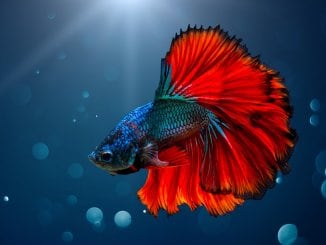
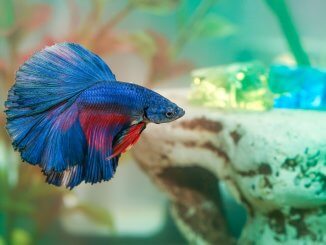
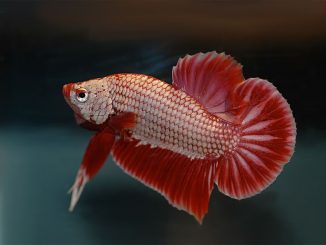

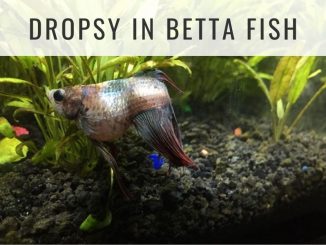
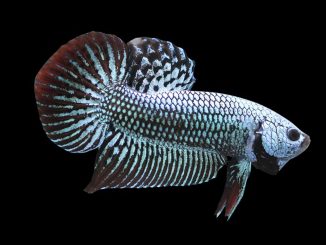
Be the first to comment